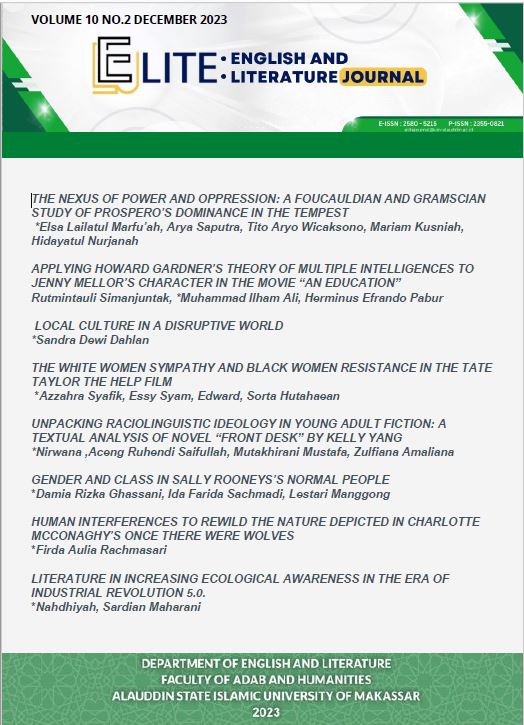GENDER AND CLASS IN SALLY ROONEY’S NORMAL PEOPLE
Abstrak
Normal People (2018), novel karya Sally Rooney, menghadirkan isu gender dan kelas melalui penggambaran dua perspektif berbeda dari tokoh utamanya, Connell dan Marianne. Artikel ini mengkaji bagaimana novel ini menggambarkan isu gender dan kelas yang digambarkan melalui hubungan Connell dan Marianne sebagai pasangan. Dengan menggunakan teori naratif Bal dan Genette, serta teori Haslanger dan Raewyn Connell tentang gender dan teori Bourdieu tentang kelas sosial, artikel ini berfokus pada cara diskriminasi gender dan kelas memengaruhi hubungan Connell dan Marianne. Temuan dan pembahasan menunjukkan bahwa penindasan yang dialami Marianne terkait dengan internalisasi penindasan, seksisme, dan misogini. Pembahasan dalam artikel ini menunjukkan bahwa maskulinitas hegemonik juga berperan dalam hal bagaimana perbedaan kelas Connell dan Marianne dihadirkan. Meskipun Marianne lebih superior dalam hal kelas, ia lebih inferior dalam hal gender daripada Connell yang berasal dari lingkungan kelas pekerja. Namun, novel ini menyajikan bagaimana persepsi karakter utama berubah karena pada akhirnya mereka tidak lagi mempermasalahkan gender dan kelas mereka. Kami berargumentasi bahwa novel tersebut tidak setuju dengan perasaan inferior yang disebabkan oleh perbedaan gender dan kelas.
##plugins.generic.usageStats.downloads##
Referensi
Bal, Mieke. (1999). Narratology Introduction to the Theory of Narrative. Toronto: University of Toronto Press.
Bourdieu, Pierre. (1989). Social space and symbolic power. Sociological Theory, 7(1), 14-25. https://doi.org/10.2307/202060.
Bourdieu, Pierre. (1987). Bordieu: What makes a social class?: On the theoretical and practical existence of groups. Berkeley Journal of Sociology: A Critical Review, 32, 1–17. dialnet.unirioja.es/servlet/articulo?codigo=3924102
Brockes, Emma. (2021). Sally Rooney on the hell of fame: ‘It doesn’t seem to work in any real way for anyone. The Guardian, 28 Aug. www.theguardian.com/books/2021/aug/28/sally-rooney-hell-of-fame-normal-people. Accessed July 3, 2023.
Connell, Raewyn. (2005). Hegemonic masculinity: Rethinking the concept. Gender and Society, 19(6), 829-859.
Connell, R. W. (2020). Masculinities. Australia: Routledge.
Constantinescu, Sorana-Alexandra. (2021). How does the internalization of misogyny operate: A theoretical approach with European examples. Research in Social Change, 13(1), 120-128. DOI: 10.2478/rsc-2021-0013
Cumming, Ed. (2020). Normal People review: Adaptation of Sally Rooney’s intense love story is pitch-perfect. Independent. April 2020. https://www.independent.co.uk/arts-entertainment/tv/reviews/normal-people-review-bbc-sally-rooney-daisy-edgar-jones-paul-mescal-cast-stream-watch-a9476261.html. Accessed July 3, 2023.
Donaldson, Mike. (1993). What is hegemonic masculinity?, Theory and Society, 22(5), 643–57. https://doi.org/10.1007/bf00993540.
Donohue, Cecilia. (2021). ‘“Normal People” indeed!’: Anne Tyler, Sally Rooney, and the narrative of youthful quirk. Irish Journal of American Studies Online. 10, 47-58. https://www.jstor.org/stable/10.2307/27139696
Eppel, Alan. (2020). Normal People: The self-at-worst and the self-at-best. Journal of Psychiatry Reform, 8(5).
Genette, Gérard. (1980). Narrative Discourse: An Essay in Method. New York: Cornell University Press.
Haslanger, Sally. (2012). Resisting Reality: Social Construction and Social Critique. Oxford: Oxford University Press.
Holmes, Linda. (2020). Normal People is a love story to cherish. NPR. April 2020. https://www.npr.org/2020/04/29/847617296/normal-people-is-a-love-story-to-cherish Accessed July 3, 2023.
Joppke, Christian. (1986). The cultural dimensions of class formation and class struggle: On the social theory of Pierre Bourdieu. Berkeley Journal of Sociology, 31, 53-78.
Mangan, Lucy. (2020). Normal People review–Sally Rooney's love story is a small-screen triumph. The Guardian. April 2020. https://www.theguardian.com/tv-and-radio/2020/apr/26/normal-people-review-sally-rooney-bbc-hulu Accessed July 3, 2023.
O’Doherty, Malachi. (2020). Changed normality. Fortnight, 479, 40-43. https://www.jstor.org/stable/10.2307/26991409
Pierini, Francesca. (2021). “Sharing the same soil:” Sally Rooney’s Normal People and the coming-of-age romance. Prospero. 26, 145-170. https://doi.org/10.13137/2283-6438/33293
Poniewozik, James. (2020). Normal People review: Their love will tear you apart. The New York Times. April 2020. https://www.nytimes.com/2020/04/28/arts/television/normal-people-review.html Accessed July 3, 2023.
Rooney, Sally. (2018). Normal People. London: Faber and Faber.
Russell, Anna. (2020). How Normal People makes us fall in love. The New Yorker. May 2020. https://www.newyorker.com/culture/on-television/how-normal-people-makes-us-fall-in-love Accessed July 3, 2023.
Sarıkaya-Şen, Merve. (2021). A relentless quest for a paradoxical normality: Sally Rooney’s Normal People. Çankaya University Journal of Humanities and Social Sciences, 15(1), 79–90. https://doi.org/10.47777/cankujhss.959429.
##submission.copyrightStatement##
##submission.license.cc.by-nc-sa4.footer##Once an article was published in the journal, the author(s) are:
granted to the journal right licensed under Creative Commons License Attribution that allows others to share the work with an acknowledgement of the work's authorship.
permitted to publish their work online in third parties as it can lead wider dissemination of the work.
continue to be the copyright owner and allow the journal to publish the article with the CC BY-NC-SA 4.0 license
receiving a DOI (Digital Object Identifier) of the work.


